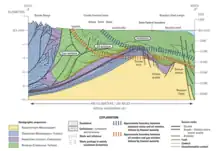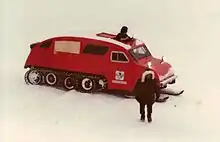
The Alaska North Slope (Iñupiaq: Siḷaliñiq) is the region of the U.S. state of Alaska located on the northern slope of the Brooks Range along the coast of two marginal seas of the Arctic Ocean, the Chukchi Sea being on the western side of Point Barrow, and the Beaufort Sea on the eastern. With the exception of the highway connecting Fairbanks to Prudhoe Bay, the region is disconnected from the rest of the Alaskan road system and relies mostly on waterways and small airports for transportation due to the Brooks Range secluding the region from the rest of the state.[1]
The entire Arctic coastal plain of Alaska with its Arctic coastal tundra has tremendous ecological importance with the densest concentration of birds in the Arctic, along with housing substantial amounts of large mammals such as whales, walrus, seals, caribou, and moose.[1] The region includes the Arctic National Wildlife Refuge as well as the National Petroleum Reserve–Alaska.
Topography

Within the North Slope, only a surface "active layer" of the tundra thaws each season; most of the soil is permanently frozen year-round. On top of this permafrost, water flows out to sea via shallow, braided streams or settles into pools and ponds.[2] Along the bottom of the Landsat 7 image on the right, the rugged terrain of the Brooks Range mountains is snow-covered in places (blue areas) and exposed (pink areas) in others.
Much of the region is located politically in North Slope Borough, and geographically in the Alaska North Slope basin.
On August 12, 2018, a 6.3 magnitude earthquake hit the region, the most powerful recorded for the Alaskan North Slope.[3]
Ecology
The region includes the Arctic National Wildlife Refuge. The entire coastal plain of Alaska has tremendous ecological importance with the densest concentration of birds in the Arctic.[4]
Petroleum resources



Under the North Slope is an ancient seabed, which is the source of the oil. Within the North Slope, there is a geological feature called the Barrow Arch — a belt of the kind of rock known to be able to serve as a trap for oil. It runs from the city of Utqiaġvik to a point just west of the Arctic National Wildlife Refuge.[2][5]
Ira Harkey quotes Noel Wien as stating that in the 1920s, "To keep warm and to cook with, the Eskimo was burning hunks of dark stuff he just picked up on the ground all around his tent. This was oil from seepage under the tundra. The Eskimos had always known about the oil, long before there was any drilling for it."[6]
The North Slope region includes the National Petroleum Reserve–Alaska, which was established by President Warren G. Harding in 1923 as an oil supply for the US Navy, though the presence of oil in the region had been known by American whalers for some time.[4] It contains the bulk of Alaska's known petroleum until the Prudhoe Bay Oil Field was discovered (outside the NPRA) in 1968, followed by the Kuparuk River oil field in 1969. The petroleum extracted from the region is transferred south by means of the Trans-Alaska Pipeline System to Valdez on the Pacific Ocean.[2]
In 2005 the USGS estimated that the Arctic Alaska Petroleum Province, encompassing all the lands and adjacent Continental Shelf areas north of the Brooks Range-Herald arch (see map) held more than 50 billion bbl of oil and natural-gas liquids and 227 trillion cubic feet of gas.[5]
The source rock for the Prudhoe Bay Oil Field and neighboring reserves is also a potential source for unconventional tight oil and shale gas – possibly containing "up to 2 billion barrels of technically recoverable oil and up to 80 trillion cubic feet of natural gas, according to a 2012 U.S. Geological Survey report."[7]
However Alaska North Slope (ANS) is a more expensive waterborne crude oil.[8] Since 1987, Alaska North Slope (ANS) crude production has been in decline.[9]
As of 2020, the U.S. Geological Survey estimated 3.6 billion barrels of oil and 8.9 trillion cubic feet of natural gas in Mississippian through Paleogene strata in the central North Slope of Alaska, which are undiscovered and technically recoverable.[10]
See also
References
- 1 2 Alaska Department of Commerce, Community, and Economic Development, Northern Opportunity Alaska's Economic Development Strategy, 2016, at 84 (Alaska 2016). Accessed June 1, 2023. https://www.commerce.alaska.gov/web/portals/0/pub/CEDS/2017-2022-Statewide-CEDS.pdf.
- 1 2 3 Canby, Peter (November 17, 2005). "The Specter Haunting Alaska". New York Review of Books. Archived from the original on 2005-10-31.
- ↑ "M 6.4 - 90km SW of Kaktovik, Alaska". U.S. Geological Survey.
- 1 2 "Alaska's petroleum reserve is open for drilling. Will the birds survive?". Environment. 2019-09-10. Archived from the original on April 11, 2021. Retrieved 2023-03-06.
- 1 2 Houseknecht, David W.; Bird, Kenneth J. "Studies by the U.S. Geological Survey in Alaska, 2005" (PDF).
Professional Paper 1732–A Oil and Gas Resources of the Arctic Alaska Petroleum Province
- ↑ Harkey, Ira (1991). Pioneer Bush Pilot. Bantam Books. p. 239–240. ISBN 0553289195.
- ↑ Margaret Kriz Hobson (April 3, 2013). "SHALE OIL: Geologist's Alaska gamble could turn into America's next big shale play". EnergyWire, E & E Publishing. Retrieved April 4, 2013.
- ↑ Auers, John R.; Mayes, John (5 June 2013), "North American production boom pushes crude blending", Oil & Gas Journal, Dallas, Texas, 111 (5), retrieved December 28, 2013
- ↑ Fielden, Sandy (February 1, 2013), After the Oil Rush – ANS Decline and the West Coast Crude Market, RBN Energy, retrieved 27 December 2013
- ↑ Houseknecht, David W.; Whidden, Katherine J.; Connors, Christopher D.; Lease, Richard O.; Schenk, Christopher J.; Mercier, Tracey J.; Rouse, William A.; Botterell, Palma J.; Smith, Rebecca A. (2020). "Assessment of undiscovered oil and gas resources in the Central North Slope of Alaska, 2020". Fact Sheet. Retrieved 2023-03-14.
External links
- DOE report on North Slope Oil and Gas
- northslope.org, North Slope Science Initiative official website
- "North Slope of Alaska". NASA Earth Observatory newsroom. 2006-02-19. Archived from the original on 2008-09-24. Retrieved 2009-12-22.
